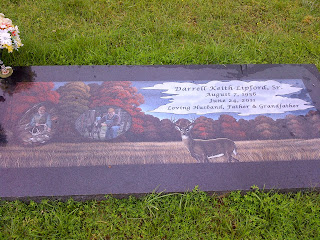In most cases you will have the deceased's name, date of birth, and date of death sandblasted or etched on the monument, along with a personal message or prayer. You may also consider adding pieces of funerary art, to add even more personalization to the granite. Many people also like to inset a photograph of the deceased in a brass or bronze frame.
Monuments usually sit as "uprights" with heart-shaped, rounded, gabled, square or other shaped tops. Decorating with memento mori (symbolic reminders of death) such as skulls or winged skulls, winged cherub heads, and heavenly crowns began sometime in the 18th century. Throughout the years, more elaborate allegorical figures were added, such as Old Father Time, or emblems of trade or status, or even important life events of the deceased, including how they may have passed.
Sandblasted and etched components (also called "emblems") are often used on upright and flat monuments in today's cemeteries. These emblems indicate recurring themes in both faith and life.
Here are a few Examples:
|
|
Greek letters and abbreviations may also be used:
(alpha and omega) - The beginning and the end
(chi rho) - The first letters spelling the name of Christ
- IHS - Stylized version of iota-eta-sigma, a Greek abbreviation of Jesus







